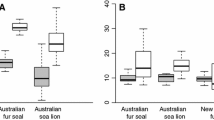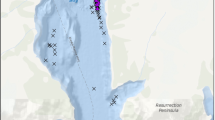Abstract
The shortfin mako shark, Isurus oxyrinchus, is a highly streamlined epipelagic predator that has several anatomical and physiological specializations hypothesized to increase aerobic swimming performance. A large swim-tunnel respirometer was used to measure oxygen consumption (MO2) in juvenile mako sharks (swimming under controlled temperature and flow conditions) to test the hypothesis that the mako shark has an elevated maintenance metabolism when compared to other sharks of similar size swimming at the same water temperature. Specimen collections were conducted off the coast of southern California, USA (32.94°N and 117.37°W) in 2001-2002 at sea-surface temperatures of 16.0–21.0°C. Swimming MO2 and tail beat frequency (TBF) were measured for nine mako sharks [77–107 cm in total length (TL) and 4.4 to 9.5 kg body mass] at speeds from 28 to 54 cm s−1 (0.27–0.65 TL s−1) and water temperatures of 16.5–19.5°C. Standard metabolic rate (SMR) was estimated from the extrapolation to 0-velocity of the linear regression through the LogMO2 and swimming speed data. The estimated LogSMR (±SE) for the pooled data was 2.0937 ± 0.058 or 124 mg O2 kg−1 h−1. The routine metabolic rate (RMR) calculated from seventeen MO2 measurements from all specimens, at all test speeds was (mean ± SE) 344 ± 22 mg O2 kg−1h−1 at 0.44 ± 0.03 TL s−1. The maximum metabolic rate (MMR) measured for any one shark in this study was 541 mg O2 kg−1h−1 at 54 cm s−1 (0.65 TL s−1). The mean (±SE) TBF for 39 observations of steady swimming at all test speeds was 1.00 ± 0.01 Hz, which agrees with field observations of 1.03 ± 0.03 Hz in four undisturbed free-swimming mako sharks observed during the same time period. These findings suggest that the estimate of SMR for juvenile makos is comparable to that recorded for other similar-sized, ram-ventilating shark species (when corrected for differences in experimental temperature). However, the mako RMR and MMR are apparently among the highest measured for any shark species.



Similar content being viewed by others
References
Bainbridge R (1958) The speed of swimming of fish as related to size and to the frequency and amplitude of the tail beat. J Exp Biol 35:109–133
Bernal D, Sepulveda CA, Graham JB (2001a) Water-tunnel studies of heat balance in swimming mako sharks. J Exp Biol 204:4043–4054
Bernal D, Dickson KA, Shadwick RE, Graham JB (2001b) Analysis of the evolutionary convergence for high performance swimming in lamnid sharks and tunas. Comp Biochem Physiol 129:695–726
Bernal D, Sepulveda CA, Mathieu-Costello O, Graham JB (2003) Comparative studies of high performance swimming in sharks: I. Red muscle morphometrics, vascularization, and ultrastructure. J Exp Biol 206:2831–2843
Bernal D, Donley JM, Shadwick RE, Syme DA (2005) Mammal-like muscles power swimming in a cold-water shark. Nature 437:1349–1352
Blank JM, Farwell CJ, Morrissette JM, Schallert RJ, Block BA (2007) Influence of swimming speed on metabolic rates of juvenile Pacific bluefin tuna and yellowfin tuna. Physiol Biochem Zool 80:167–177
Brett JR, Blackburn JM (1978) Metabolic rate and energy expenditure of the spiny dogfish, Squalus acanthias. J Fish Res Board Can 35:816–821
Brett JR, Groves TDD (1979) Physiological energetics. In: Hoar WS, Randall DJ, Brett JR (eds) Fish physiology. vol VIII. Academic, New York, pp 280–344
Brill RW (1987) On the standard metabolic rates of tropical tunas, including the effect of body size and acute temperature change. Fish Bull 85:25–36
Brill RW (1996) Selective advantage conferred by the high performance physiology of tunas, billfishes, and dolphin fish. Comp Biochem Physiol 113A:2–15
Bushnell PG, Lutz PL, Gruber SH (1989) The metabolic rate of an active, tropical elasmobranch, the lemon shark, Negaprion brevirostris. J Exp Biol 48:279–283
Carey FG, Teal JM (1969) Mako and porbeagle: warm bodied sharks. Comp Biochem Physiol 28:199–204
Carey FG, Teal JM, Kanwisher JW, Lawson KD (1971) Warm bodied fish. Am Zool 11:135–145
Carey FG, Casey JG, Pratt HL, Urquhart D, McCosker JE (1985) Temperature, heat production and heat exchange in lamnid sharks. Mem South Calif Acad Sci 9:92–108
Carlson JK, Parsons GR (2003) Respiratory and hematological responses of the bonnethead shark, Sphyrna tiburo, to acute changes in dissolved oxygen. J Exp Mar Biol Ecol 294:15–26
Carlson JK, Palmer CL, Parsons GK (1999) Oxygen consumption rate and swimming efficiency of the blacknose shark, Carcharhinus acronotus. Copeia 1999:34–39
Carlson JK, Goldman KJ, Lowe CG (2004) Metabolism, energetic demand, and endothermy. In: Carrier JC, Musick JA, Heithaus MR (eds) Biology of sharks and their relatives. CRC, Boca Raton, pp 203–224
Dewar H, Graham JB (1994) Studies of tropical tuna swimming performance in a large water tunnel I. Energetics. J Exp Biol 192:13–31
Dickson KA, Graham JB (2004) Evolution and consequences of endothermy in fishes. Physiol Biochem Zool 77:998–1018
Donley JM (2004) Mechanics of steady swimming and contractile properties of muscle in elasmobranch fishes. Ph.D. Dissertation, Scripps Institution of Oceanography
Donley JM, Sepulveda CA, Konstantinidis P, Gemballa S, Shadwick RE (2004) Convergent evolution in mechanical design of lamnid sharks and tunas. Nature 429:61–65
Dowd WW, Brill RW, Bushnell PG, Musick JA (2006) Standard and routine metabolic rates of juvenile sandbar sharks (Carcharhinus plumbeus), including the effects of body mass and acute temperature change. Fish Bull 104:323–331
Emery SH (1986) Hematological comparisons of endothermic vs ectothermic elasmobranch fishes. Copeia 1986:700–705
Emery SH, Szczepanski A (1986) Gill dimensions in pelagic elasmobranch fishes. Biol Bull 171:441–449
Foskett KJ, Bern HA, Machenf TE, Conner M (1983) Chloride cells and the hormonal control of teleost fish osmoregulation. J Exp Biol 106:255–281
Gemballa S, Konstantinidis P, Donley JM, Sepulveda CA, Shadwick RE (2006) Evolution of high-performance swimming in sharks: Transformations of the musculotendinous system from subcarangiform to thunniform swimmers. J Morph 267:477–493
Graham JB, Koehrn FJ, Dickson KA (1983) Distribution and relative proportions of red muscle in scombrid fishes: consequences of body size and relationships to locomotion and endothermy. Can J Zool 61:2087–2096
Graham JB, Dewar H, Lai NC, Lowell WR, Arce SM (1990) Aspects of shark swimming performance determined using a large water tunnel. J Exp Biol 151:175–192
He P, Wardle CS (1986) Tilting behaviour of the Atlantic mackerel, Scomber scombrus, at low swimming speeds. J Exp Biol 29:223–232
Hove JR, Moss SA (1997) Effect of MS-222 on response to light and rate of metabolism of the little skate Raja erinacea. Mar Biol 128:579–583
Lai NC, Korsmeyer KE, Katz S, Holts DB, Laughlin LM, Graham JB (1997) Hemodynamics and blood properties of the shortfin mako shark (Isurus oxyrinchus). Copeia 1997:424–428
Lowe CG (1996) Kinematics and critical swimming speed of juvenile scalloped hammerhead sharks. J Exp Biol 199:2605–2610
Lowe CG (2001) Metabolic rates of juvenile scalloped hammerhead sharks (Sphyrna lewini). Mar Biol 139:447–453
Magnuson JJ (1973) Comparative study of adaptations for continuous swimming and hydrostatic equilibrium of scombroid and xiphoid fishes. Fish Bull 71:337–356
Pang PKT Griffith RW, Atz JW (1977) Osmoregulation in elasmobranchs. Am Zool 17:365–377
Scharold J, Gruber SH (1991) Telemetered heart rates as a measure of metabolic rate in the lemon shark, Negaprion brevirostris. Copeia 1991:942–953
Scharold J, Lai NC, Lowell WR, Graham JB (1989) Metabolic rate, heart rate, and tailbeat frequency during sustained swimming in the leopard shark Triakis semifasciata. J Exp Biol 48:223–230
Sepulveda CA, Dickson KA (2000) Maximum sustainable speeds and cost of swimming in juvenile kawakawa tuna, Euthynnus affinis, and chub mackerel, Scomber japonicus. J Exp Biol 203:3089–3101
Sepulveda CA, Dickson KA, Graham JB (2003) Swimming performance studies on the eastern Pacific bonito Sarda chiliensis, a close relative of the tunas (family Scombridae). I. Energetics. J Exp Biol 206:2739–2748
Sepulveda CA, Wegner NC, Bernal Graham JB (2005) The red muscle morphology of the thresher sharks (family Alopiidae). J Exp Biol 208:4255–4261
Smith SE (1984) Timing of vertebral-band deposition in tetracycline-injected leopard sharks. Am Fish Soc 113:308–313
Sokal RR, Rohlf FJ (1998) Biometry: The principles and practice of statistics in biological research. WH Freeman and Company, New York
Stillwell CE, Kohler NE (1982) Food, feeding habits, and estimates of daily ration of the shortfin mako (Isurus oxyrinchus) in the North Atlantic. Can J Fish Aquat Sci 39:407–414
Videler JJ, Nolet BA (1990) Costs of swimming measured at optimum speed: Scale effects, differences between swimming styles, taxonomic groups and submerged and surface swimming. Comp Biochem Physiol 97A: 91–99
Webb PW (1971) The swimming energetics of trout I. Thrust and power output at cruising speeds. J Exp Biol 55:489–520
Webb PW (1993) The effect of solid and porous channel walls on steady swimming of steelhead trout Oncorhynchus mykiss. J Exp Biol 178:97–108
Webb PW (1998) Swimming. In: Evans DH (ed) The physiology of fishes. CRC, New York, pp 3–24
Webb PW (2002) Control of posture, depth, and swimming trajectories of fishes. Integr Comp Biol 42:94–101
Acknowledgments
We thank the following agencies for their direct and indirect support of this work, the National Science Foundation (IOB-0077502, IOB-0091987), California Sea Grant (R/F-85PD; R/F-193), Darryl Lewis and the William H. and Mattie Wattis Harris Foundation, the Scripps Institution of Oceanography Director’s Office, Tom Pfleger, and the George T. Pfleger Foundation. We would like to thank J. Valdez for logistical support and the following individuals who assisted, in one form or another, with this project: Jeanine Donley, Doug Syme, Robert Shadwick, Richard Rosenblatt, John Steinitz, Hawkins Dowis, Corey Chan, Nick Wegner, Dan Cartamil, Heather Lee, Scootch Aalbers, Phil Zerofski, Nicholas Sepulveda, Thomas Fullam, Victoria Wintrode, Ashley Knight, Jennifer Nusban, and the vertebrate collection at SIO (H.J. Walker and Cindy Klepadlo). This work is in memory of G. Bernal and F. Ledet, you will be missed.
Author information
Authors and Affiliations
Corresponding author
Additional information
Communicated by J.P. Grassle.
Rights and permissions
About this article
Cite this article
Sepulveda, C.A., Graham, J.B. & Bernal, D. Aerobic metabolic rates of swimming juvenile mako sharks, Isurus oxyrinchus . Mar Biol 152, 1087–1094 (2007). https://doi.org/10.1007/s00227-007-0757-2
Received:
Accepted:
Published:
Issue Date:
DOI: https://doi.org/10.1007/s00227-007-0757-2




